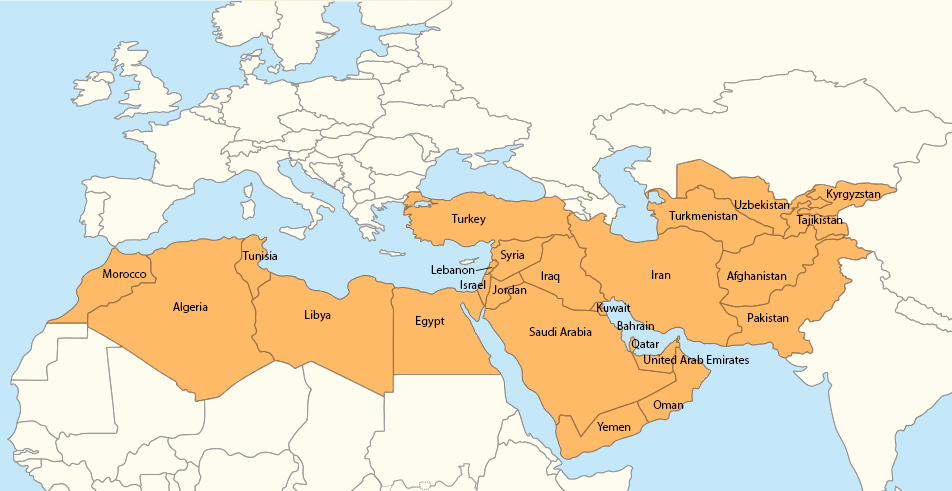Introduction
Alam Payind and Melissa McClimans
This book is intended for readers who have never studied the Middle East, or who would like to improve their knowledge of the region. Key concepts are demarcated with text boxes throughout, and a glossary is provided which includes those and other important words from each chapter. This book is intended as a starting point for insider literacy. This is why we provide key terms in the local languages as much as possible. This is not a history book, although we discuss milestones and key historical figures within the contexts of ancient and modern civilizations. Our goal is for the reader to understand some introductory perspectives coming from within the region, and begin building knowledge regarding what informs them. We consider it important not to advocate for a particular community’s view, but to challenge readers to understand multiple perspectives. Whether the reader is a novice or scholar, we expect these fundamentals will be of value. These include: the languages, the cultural, religious and sectarian communities of the region, and turning points in history, such as:
- The establishment of the early Islamic Empires which played a key role in establishing Arabic as a dominant language in the region.
- The schism of Islam into Sunni and Shi‘i factions, which continues to shape the region today.
- The legacies of imperialism, the Cold War and Global Alliances such as NATO, which continue to impact the region.
The choices we’ve made regarding what to include are informed by what we have been repeatedly told by many of the students in our classes. There are many more languages, religions and cultural communities in the region beyond what we could cover here, but we do our best to acknowledge as many as possible. Whether the reader is a novice or scholar, we expect these fundamentals will be of value.

Map: Map of the Greater Middle East
List of Countries: The Countries of the Middle East and Surrounding Regions with Muslim Population
Alphabet Key: Arabic Romanization/Transliteration Chart
The following chapters focus on the languages, cultural, religious and sectarian communities of the region, and certain turning points in history which are keys for understanding the region, whether for establishing a new knowledge base, or deepening one’s knowledge. In addition to language and nationality (or ethnic identity), religious communities play a huge role in the Middle East. We therefore cover, language communities, cultural communities and religious communities which combine to create many unique, complex identities of the Middle East.
Chapter one focuses on the languages spoken in the region. The countries we have included (see chart, next page) possess a significant population of speakers of one or more of the following languages: Arabic, Hebrew, Persian or Turkish (or, closely-related Turkic languages). Chapter two also acknowledges some of the ancient languages of the Middle East with global significance in regard to such innovations in human culture as writing.
Chapter two provides an overview of some of the major religious identities of the region, past and present. It also addresses the religious diversity and importance of minority religions and factions within major religions. Islam is explored in detail, especially in relation to multiple schools of thought and the premises of Islamic law. Except for Israel, each of these states are also Muslim-majority. This book acknowledges the major cultural influence Islam has had on the region, as well as its religious diversity.
Chapter three covers critical developments in the Middle East related to the effects of European colonialism in the region and the Cold War. The chart on the previous page shows which countries we cover, along with their Muslim populations. Please keep in mind, however, that the Muslim population of the Middle East makes up only 42% of the total worldwide Muslim population (Pew,2011 – see chart below). Furthermore, we are using one of the broadest definitions of the Middle East possible in this book.
| Muslim-Majority Countries of the Middle East | ||
| Middle Eastern Country | Population | Percent of Muslims Worldwide |
| Afghanistan | 29,047,000 | 2% |
| Algeria | 34,780,000 | 2% |
| Bahrain | 655,000 | 0% |
| Egypt | 80,024,000 | 5% |
| Pakistan | 178,097,000 | 11% |
| Palestinian Territories | 4,298,000 | 0% |
| Iran | 74,819,000 | 5% |
| Iraq | 31,108,000 | 2% |
| Israel | 1,287,000 | 0% |
| Jordan | 6,397,000 | 0% |
| Kazakhstan | 8,887,000 | 1% |
| Kuwait | 2,636,000 | 0% |
| Kyrgyzstan | 4,927,000 | 0% |
| Lebanon | 2,542,000 | 0% |
| Libya | 6,325,000 | 0% |
| Morocco | 32,381,000 | 2% |
| Oman | 2,547,000 | 0% |
| Qatar | 1,168,000 | 0% |
| Saudi Arabia | 25,493,000 | 2% |
| Syria | 20,895,000 | 1% |
| United Arab Emirates | 3,577,000 | 0% |
| Tajikistan | 7,006,000 | 0% |
| Tunisia | 10,349,000 | 1% |
| Turkey | 74,660,000 | 5% |
| Turkmenistan | 4,830,000 | 0% |
| Uzbekistan | 26,833,000 | 2% |
| Yemen | 24,023,000 | 2% |
| Total of Selected Countries | 699,591,000 | 44% |
| Total Muslim Population | 1,600,000,000 | 100% |
| Data source: | Pew Forum, Muslim Population Data | |
